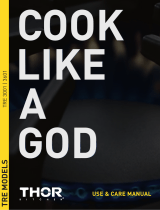
4
IMPORTANT SAFETY INSTRUCTIONS
•Donotusewaterorourongreaseres—
smothertherewithapanlid,orusebaking
soda, a dry chemical or foam-type extinguisher.
•Whenheatingfatorgrease,watchitclosely. Fat
or grease may catch re if allowed to become too hot.
•Usedrypotholders-moistordamppotholderson
hot surfaces may result in burns from steam. Do
not let potholders touch hot heating elements. Do not
use a towel or other bulky cloth instead of a potholder.
•Donotheatunopenedfoodcontainers-buildup
of pressure may cause container to burst and
result in injury.
IMPORTANT INSTRUCTIONS FOR USING
YOUR OVEN
•Usecarewhenopeningovendoor,loweroven
door or warmer drawer (if equipped)—Stand to
the side of the range when opening the door of a hot
oven. Let hot air or steam escape before you remove or
replace food in the oven.
•Keepovenventductsunobstructed. The oven vent
is located under the left rear surface element if your
model is equipped with coil elements. The oven vent
is located below the backguard for models equipped
with ceramic-glass cook tops. Touching the surfaces in
this area when the oven is operating may cause severe
burns. Also, do not place plastic or heat-sensitive items
on or near the oven vent. These items could melt or
ignite.
•Placementofinteriorovenracks. Always place
oven racks in desired location while oven is cool. If rack
must be moved while oven is hot use extreme caution.
Use potholders and grasp the rack with both hands to
reposition. Do not let potholders contact the hot heating
elements in the oven. Remove all utensils from the rack
before moving.
•Donotusethebroilerpanwithoutitsinsert. The
broiler pan and its insert allow dripping fat to drain
and be kept away from the high heat of the broiler. Do
not cover the broiler insert with aluminum foil.
Exposed fat and grease could ignite.
•Protectiveliners—Do not use aluminum foil to line the
oven bottom. Only use aluminum foil as recommended
in this manual. Improper installation of these liners may
result in risk of electric shock, or re.
WARNING
•Storageinoronappliance—ammablematerials
should not be stored in an oven, warmer drawer,
near surface units or in the storage drawer.
This includes paper, plastic and cloth items, such
as cookbooks, plasticware and towels, as well as
ammable liquids. Do not store explosives, such as
aerosol cans, on or near the range.
•DONOTLEAVECHILDRENALONE—children
should not be left alone or unattended in the
area where appliance is in use. They should
never be allowed to sit or stand on any part of the
appliance, including the storage drawer, lower broiler
drawer, warmer drawer or lower double oven.
CAUTION
•Donotstoreitemsofinteresttochildreninthe
cabinets above a range or on the backguard of
the range. Children climbing on the range to reach
items could be seriously injured.
•Donottouchsurfaceheatingunitsorsurface
cooking elements, areas near these units or
elements, or interior surface of the oven. Both
surface heating and oven heating elements may be hot
even though they are dark in color. Areas near surface
cooking units may become hot enough to cause burns.
During and after use, do not touch, or let clothing or
other ammable materials touch these areas until they
have had sufcient time to cool. Among these areas
are the cook top, surfaces facing the cook top, the
oven vent openings and surfaces near these openings,
oven door and oven door window.
•Wearproperapparel—loose-ttingorhanging
garments should never be worn while using the
appliance. Do not let clothing or other ammable
materials contact hot surfaces.
IMPORTANT
Do not attempt to operate the range during a
power failure. If the power fails, always turn off the
range. If the range is not turned off and the power
resumes, the range will begin to operate again. Once the
power resumes, reset the clock and oven function.
















